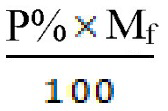FIELD: agriculture.
SUBSTANCE: method includes satellite monitoring of the condition of the seeded crops within a specific field, followed by building vegetation maps based on the NDVI index and determining problem sites whereon plant samples are collected for rapid testing. The rapid testing includes the preparation of a solution for isolating chloroplasts, wherein 10 g of sodium chloride is taken therefor, dissolved in 500 cm3 distilled water – solution 1. Also prepared is a solution for conducting a reaction to determine the photochemical activity of the chloroplasts, including the dissolution of 1 g sodium chloride in 500 cm3 distilled water – solution 2, followed by placing the solution in 20 test tubes, 10 ml in each, and adding 0.1 cm3 standard solutions of macro- and microelements using a pipette dispenser. To prepare a chloroplast suspension, leaves 3 to 4 from the top of adult plants or a whole young plant are used, wherein plants most characteristic of the area under study are selected for the average sample. The term of delivery of the leaves for testing should be no later than 30 to 40 minutes; the average sample is then ground with solution 1 in a 1:10 ratio and CaCO3 is added at the tip of a spatula, followed by filtering the chloroplast suspension through 4 layers of gauze cloth into a test tube. 0.5 ml doses are collected from the resulting suspension and poured sequentially into the 20 test tubes of the prepared solutions with macro- and microelements. 0.05 ml of a dye solution is added to each test tube, followed by measuring the optical density on a photoelectric colorimeter at a wavelength of 620 nm, then illuminating the cuvette for 20 to 30 seconds with a light source and re-measuring the optical density. The difference between the optical densities of the two measurements is used to assess the activity of chloroplasts, followed by compiling a table of the resulting values of changes in the optical density, wherein the insufficiency or excess of the tested nutrition elements is recalculated as a percentage, followed by calculating the amount of fertilisers for foliar fertilisation according to the following formula: X= , wherein P% is the deviation from the optimum for each element, Mf is the mass of fertiliser in grams or kilograms with 100% insufficiency.
, wherein P% is the deviation from the optimum for each element, Mf is the mass of fertiliser in grams or kilograms with 100% insufficiency.
EFFECT: more accurate determination of the need for nutrition elements of the seeded crops for the purpose of increasing the efficiency of adding doses of mineral fertilisers with account to the content of macro- and microelements in plants at various sites of the field; higher efficiency of agrochemical testing.
1 cl, 3 dwg, 1 ex
| Title | Year | Author | Number |
|---|---|---|---|
| METHOD OF DIAGNOSIS OF PLANTS NEED IN NUTRITION ELEMENTS TAKING INTO ACCOUNT PHYSIOLOGICAL STATE OF PLANTS | 2012 |
|
RU2511311C1 |
| METHOD FOR DETERMINING THE LACK OF NITROGEN IN THE NUTRITION OF WINTER WHEAT PLANTS | 2022 |
|
RU2787129C1 |
| METHOD FOR DIAGNOSING LEVEL OF TOTAL NITROGEN IN LEAVES OF WINTER WHEAT PLANTS | 2024 |
|
RU2838677C1 |
| ORGANO-MINERAL PREPARATION FOR FOLIAR FEEDING OF SUNFLOWER | 2022 |
|
RU2787041C1 |
| METHOD FOR FOLOW FERTILIZATION IN SOYBEAN AND RAPSE GROWING | 2022 |
|
RU2789878C1 |
| METHOD FOR VEGETATIVE FEEDING OF FARM CROPS | 2002 |
|
RU2221359C1 |
| METHOD FOR INCREASING YIELD OF WINTER WHEAT | 2020 |
|
RU2753974C1 |
| METHOD OF GRAIN TREATMENT OF SPRING WHEAT AND CORN FOR SILAGE | 2013 |
|
RU2532031C1 |
| ORGANO-MINERAL PREPARATION FOR FOLIAR TOP DRESSING OF WINTER WHEAT | 2020 |
|
RU2753584C1 |
| METHOD FOR LEAF DIAGNOSTICS OF PLANTS NEED FOR MINERAL NUTRIENTS | 2023 |
|
RU2832517C1 |
Authors
Dates
2022-12-19—Published
2022-04-12—Filed